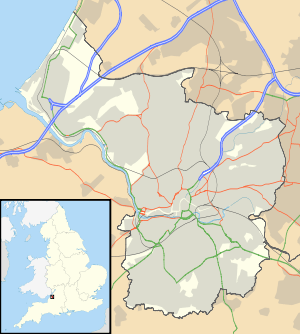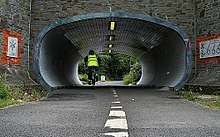Fishponds
Fishponds is a large outer suburb in the north-east of the English city of Bristol, about 3 miles (5 km) from the city centre. It has two large Victorian-era parks: Eastville Park and Vassall's Park (formerly the Vassall's Family estate, also known locally as Oldbury Court). The River Frome runs through both parks, with the Frome Valley Walkway alongside it. A restored mill can be found at Snuff Mills near the Vassall's Park end of the river. It has retained its original waterwheel, which can still be seen and heard turning. Eastville Park has its own large boating lake, with central wildlife reserves.
| Fishponds | |
|---|---|
 Fishponds Location within Bristol | |
| Population | 37,575 [1][2] |
| OS grid reference | ST637758 |
| Unitary authority | |
| Ceremonial county | |
| Region | |
| Country | England |
| Sovereign state | United Kingdom |
| Post town | BRISTOL |
| Postcode district | BS16 |
| Dialling code | 0117 |
| Police | Avon and Somerset |
| Fire | Avon |
| Ambulance | South Western |
| UK Parliament | |

Fishponds is mainly residential through which two main bus routes pass. Housing is typically of the terraced Victorian variety. The high street has many shops, such a butchers, charity shops and takeaways as well as Lidl, Aldi and Morrisons supermarkets. There is a small student population due to the presence of the Glenside campus of the University of the West of England.
The name of this area of Bristol derives from when it was, like nearby Soundwell, a quarry district. The empty quarries were then filled and there were many large fishponds in the area which have since been filled in. There was one pond remaining until the mid-1970s, when it was officially closed, a popular swimming area, named "The Lido" by locals. It is now owned by a private angling club.
Facilities

Public houses/pubs in Fishponds
There are currently sixteen pubs in Fishponds, most of which date from the Victorian era.[3] Two are modern conversions; the Old Post Office, and the VanDyke, built as a 1200 seat cinema in 1926, it closed in 1973. The Star (built 1853), was formerly the headquarters of Bristol Rovers football club when they played as the Black Arabs in the 1890s.[4]
Others include the Farriers Arms, now closed and boarded up (built 1872), Railway Tavern (built 1867), Fishponds Tavern, now converted to two houses (built 1904), Full Moon, now the New Moon (built 1850), Golden Lion (built 1883), Cross Keys now closed (built 1853), Cross Hands (built 1853), Old Tavern now closed (built 1899), Greyhound (built 1883), Spotted Cow (built 1883), Portcullis (built 1853), the Warwick Arms (built 1906), and the Oldbury Court (built 1957). Most are along the Fishponds Road running from Downend and Staple Hill to the north down towards Eastville to the south.
Transport
Buses
Fishponds is principally served by First West of England buses 48/48A/49, 17, Y2 & Y5, with 5 and 6 & 7 serving the outskirts.[5]
Trains and trams
Fishponds railway station was open from 1866 until closure in 1965 and included a shunting line for Fishponds built locomotives of the Avonside Locomotive Works to join the main line. The Bristol & Bath Railway Path now runs down the old line, and can be accessed at several points in Fishponds. The Bristol Tramway also operated from Old Market to Fishponds tram terminus from 1897 to 1941. The suburb, like most of eastern Bristol, is currently unserved by rail. The two nearest stations to Fishponds are Stapleton Road railway station and Filton Abbey Wood railway station. The reopening of the Henbury loop line will include the reopening of two railway stations in north Bristol, Henbury and North Filton. The latter will be a short distance west of Fishponds.
Local government
Fishponds is within the city, county and unitary authority of Bristol. Most of Fishponds falls within the Frome Vale council ward. The southern part falls within the Hillfields ward, and the western part falls within the Eastville ward.
Demography
The outskirts of Fishponds to the south comprise Chester Park and Mayfield Park. Fishponds is bordered by five suburbs: Downend, Staple Hill, St. George, Eastville and Stapleton. At the 2011 census the Greater Fishponds area had a population of 37,575.[6]
| 2011 Ethnic Groups | Fishponds | Bristol |
|---|---|---|
| White British | 69.3% | 77.9% |
| Asian | 10.4% | 5.5% |
| Black | 8.8% | 6.0% |
History

The area of Fishponds was once covered by the Royal Forest of Kingswood. The forest was progressively reduced and developed over the centuries, with Fishponds first recorded as the "Newe Pooles" in 1610, and subsequently "Fish Ponds" by 1734.[7] By the 17th century it was a thriving village with numerous stone built cottages for miners and quarrymen who quarried for coal and pennant stone. The village grew up around the two pools formed from the old quarries, but both were filled in by 1839.
During the mid-to-late 19th century, Fishponds established a large manufacturing industry along Lodge Causeway and Filwood Road.
Engineering and railway
Fishponds has been the site for several metal foundries, including George Adlam & Sons founded in the 1830s and Parnall & Sons, who had a foundry and scale works in Fishponds and undertook manufacture of weights, measures and shop fittings. The company would later go on to fit out ocean liner passenger compartments on the RMS Britannic in 1929 and the famous QE2 in the 1960s.
The railway was built through Fishponds in 1835, and later included a shunting line for Fishponds built locomotives of the Avonside Locomotive Works to join the main line. Peckett and Sons also built locomotives at the Atlas Works towards Speedwell, whose engines joined the line at Clay Hill until the company closed in 1961.
Chocolates and confectionery
From 1894 Palmer Bros biscuit and cake manufacturers operated on two sites on Fishponds Road, including the factory which is now part of the City Glass Company. Webers chocolates on Goodneston Road was opened in 1914 and produced chocolates for 50 years, having had production lines alongside Oerlikon 20mm cannons during World War II.
Automobile and aircraft manufacturing
Straker-Squire opened a large factory on Lodge Causeway in 1906,[8] and was a major producer of early London Buses, with the factory in Fishponds supplying 70% of market by 1909. The company also produced trucks and successfully raced a number of its own car designs, including the 2.8 litre 15, dubbed 'PDQ' (Pretty Damn Quick), which in 1912 took the 15 hp (11 kW) flying mile record at Brooklands over 95 miles per hour (153 km/h).[9] The company moved to London in 1919.
The aeronautical industry first came to Fishponds in 1914 when Brazil Straker on Lodge Causeway began building Rolls Royce aircraft engines for the RFC in World War I.[note 1][10] Cosmos Engineering bought the firm and Roy Fedden designed the Cosmos Mercury engine before the company was forced into bankruptcy and subsequently taken over by the Bristol Aeroplane Company in 1920. The site was subsequently acquired by Parnall & Sons who from 1941 produced aircraft components for a range of RAF aircraft including wings for De Havilland Tiger Moths and fuselages for Short Stirling bombers.
Postwar, Parnall & Sons continued manufacturing aircraft interiors and fuselages until about 1960. Today, Diamonite Aircraft Furnishings on Goodneston Road is supplying some of the world's best aircraft interiors, including that for the Russian President Vladimir Putin.[11]
Pottery, paper and printing
Pountney & Co moved to Fishponds in 1905 and opened a large factory on Lodge Causeway. The factory was an entirely new labour saving design and the company produced a range of domestic and luxury ceramics which were exported across the world. The Royal Cauldron name was acquired in 1962, but by then the factory was suffering from lack of investment and the company went bankrupt in 1971.[12] The factory was subsequently pulled down and the site is now occupied by the Lodge Causeway Trading Estate.
E. S. & A. Robinson opened a large cardboard box factory at Filwood Road in 1922. A subsidiary, Robinson's Waxed Paper Co. Ltd, built a new factory across the road in 1929. In World War II the company produced aircraft components for the Bristol Aeroplane Company. Robinson's merged to become the Dickinson Robinson Group in 1966 and finally closed, after further takeovers and mergers, in 1996. The two sites are now owned by Graphic Packaging and Zanetti & Company Ltd stone and marble masons, whose products and floors can be found in airports, shops and railway stations throughout the UK.
References
- Rolls-Royce Hawk engines, components for the Eagle and also Renault 80hp 8Ca engines.
- Fishponds is made up of three wards, Eastville, Frome Vale and Hillfields
- "Archived copy". Archived from the original on 13 May 2016. Retrieved 5 February 2016.CS1 maint: archived copy as title (link)
- Bristol Lost Pubs: Fishponds Archived 22 January 2008 at the Wayback Machine Retrieved on 17 April 2008.
- Historical Kits: Bristol Rovers Retrieved on 17 April 2008.
- First Group: Bristol Overground Archived 16 December 2008 at the UK Web Archive Retrieved on 17 April 2008.
- "Archived copy". Archived from the original on 13 May 2016. Retrieved 5 February 2016.CS1 maint: archived copy as title (link)
- Bristol Past: The Kingswood Forest, Stapleton and Fishponds Retrieved on 27 November 2007.
- "The Unofficial On-line Bristol Area Industrial Museum". Lightauto. Retrieved 29 August 2018.
- "Sidney Straker & Squire Limited". Unique Cars. Retrieved 29 August 2018.
- Gunston, Bill (1998). Fedden. Rolls-Royce Heritage Trust. pp. 35–37. ISBN 1-872922-13-9. Historical Series Nº26.
- Kommersant: Russian President’s Jet Goes Online Archived 26 March 2011 at the Wayback Machine Retrieved on 27 November 2007.
- Pountney & Co: Fishponds Retrieved on 27 November 2007.
- Bartlett, John Images of England, Fishponds Tempus 2004 ISBN 0-7524-3315-6
External links
![]()